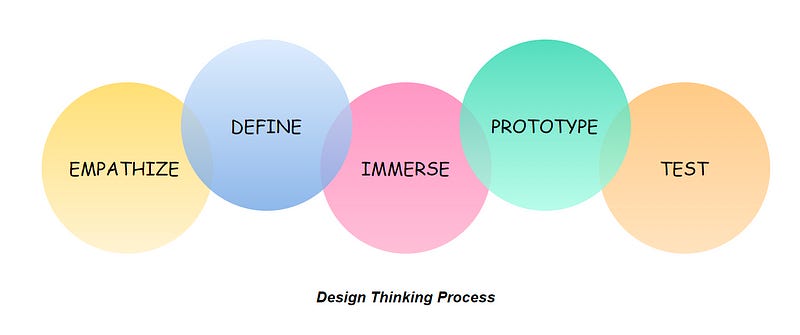Machine Learning from the Lens of Design Thinking
A Tale of Hierarchy and Machine Learning Needs
Introduction
Stepping into the world of Machine Learning (ML) and Data Science can sometimes feel like trying to solve a Rubik's cube in the dark. The problems you face are often complex and, to be honest, downright daunting. Everyone talks about thinking out-of-the-box to build cutting-edge solutions, but what we really need to understand is that machine learning is more than just building and training new models.
But where do we start? Well, first things first, it's time we give our approach to problem-solving a serious makeover. Let's talk about Design Thinking. This isn't just some fancy term thrown around in boardroom discussions but a practical, user-focused approach that will help you navigate the maze called Machine Learning. Think about it like a Swiss army knife for problem-solving.
Instead of staring at an intimidating mountain of a problem, you start seeing it as a series of smaller hills. And those hills? They're challenging, sure, but definitely not impossible to climb. With Design Thinking, you're essentially equipping yourself with a brand new toolbox filled with all the right gear to start creating some world-class solutions.
An Innovative Approach: Translating Maslow’s Hierarchy of Needs to Design Needs
Design Thinking in Machine Learning is inspired by the work of the famous American psychologist Abraham Maslow and his theory of the "Hierarchy of Needs". You might be wondering, what's the connection? Well, let's have a closer look at it.
Maslow's idea was pretty simple, yet profound. He proposed that human needs are arranged in a hierarchy, with basic needs like food and safety at the bottom and more advanced needs like self-esteem and creativity at the top. The catch is that you can't skip a level. Trying to fulfill higher-level needs without first satisfying the lower ones is like trying to build a house starting from the roof. It just doesn't work.
Maslow wasn't the only one emphasizing the importance of getting the basics right. In Machine Learning, there's this concept known as Occam's Razor, which essentially tells us that the simplest solution tends to be the best one. Now, imagine coupling this with Maslow's hierarchy - starting with the fundamental needs, not skipping any steps, and keeping it as straightforward as possible.
That's the secret sauce for approaching ML from the lens of design thinking. In machine learning, we should not just jump to create the most innovative, cutting-edge solution. We should ensure that the basic needs are met first - Is the design functional? Is it reliable? Only then should we move on to more advanced levels, like usability and creativity.
Now that we have set the stage by drawing parallels between Maslow's hierarchy of needs and the Principles of design thinking in Machine Learning, it's time to dive deeper. Let's explore each level of our design hierarchy, moving from the ground up - starting with functionality and reliability, then progressing to usability, proficiency, and finally, creativity.
Translating Maslow’s Physiological Needs to ML Design Needs
Just as Maslow stated, we can't aspire to fulfill high-level needs without securing the foundational ones. This idea translates seamlessly into the machine learning system design. We'll delve into each design need, exploring what it means and why it's crucial for successfully designing an ML system.
Functionality: A design must be able to function before anything else. For example, an MP3 player needs to be able to play, pause, rewind, and fast-forward MP3 and other digital audio files in order to be considered an MP3 player. If it can’t perform these functions, then the design has failed. A design is expected to meet basic functionality needs; doing so isn’t considered anything special. Characteristics of a website that meets functionality needs might be pages that load in a reasonable amount of time, working links, and pages that respond to basic browser buttons like “Back” and “Forward.”
Reliability: Once the design has met functional needs, it can move up to the next level in the design hierarchy: reliability. The design should now offer stable and consistent performance. It should not only work just once but should work again and again. A reliable website functions consistently, what worked yesterday should also work today. When new pages and sections are added to an existing website, they should function just as well as existing pages and sections.
Usability: Usability basically means how easily users can accomplish basic tasks. A usable design partly distinguishes your website from those on lower levels. A usable design is something which is easy to understand and use.
Proficiency: A design should always be proficient, it should allow people to do more and to do better. A design that allows people to do things not previously possible and to expand on basic functionality is considered a proficient design. A proficient website might include advanced search options, the ability to combine data from different sources into more sophisticated levels of information, and a web-based tool.
Creativity: Once we have met all the lower-level needs, we can move on to the creative needs. With these met, the design can now interact with users in innovative ways. The design can explore and create things that expand on the product itself. Designs that meet creative needs are perceived to be of the highest level.
The Power of Design Thinking in ML: A Five-Step Process
The design thinking process for machine learning consists of five key phases, Understand/ Empathize, Define, Immerse, Prototype, and Test/Evaluate. Let's take a closer look at how each of these stages helps us make sense of the problems we're trying to solve, sparks creative ideas, and leads us toward practical, useful solutions.
Understand/Empathize: The first stage of the Design Thinking process is to gain an emphatic or contextual understanding of the problem we are trying to solve. It involves consulting with experts to find out more about the area of concern through observing and engaging with stakeholders to understand their experiences and motivation. This stage of the Design Thinking process is similar to assembling a complex puzzle. Each expert consultation, observation, and conversation is a unique piece that brings us closer to seeing the complete picture.
Define: During the define stage, we put together the information that we have gathered in the first step. It's like assembling the ingredients for a meal - each piece of information, each insight, and each observation serves as a unique ingredient that will contribute to the final dish - our solution. We question not only 'what' the problem is but also 'why' it exists, its importance to our users, and its necessity to be solved. It is a critical turning point in the design thinking process that prepares the groundwork for crafting effective, user-centric solutions.
Immerse: After defining the problem in the second step, the next step is to truly immerse ourselves in understanding the users and their surrounding environment. The aim is to learn about their vision, goals, problems, passions, interests, and opinions, thus going beyond the given problem statement to get insights about the user in order to create breakthrough solutions tailored to meet the unique needs and desires of the users.
Prototype: During the Prototype stage, we should put on our explorers' hats and start creating. Drawing from the principles of agile methodology, our goal is to build a Minimum Viable Product (MVP) - a simple version of our solution that has enough features to be usable. This MVP is our investigation tool, helping us sift through possible solutions and pinpoint the best one that matches our users' needs. This step is all about experimentation and exploration. We don't just stop at the first solution we come up with. Instead, we try out many different options, testing each one to see how it works. It's like finding our way through a complex puzzle, with each attempt bringing us closer to the final picture.
Test/Evaluate: This step includes rigorous testing of the complete product using the best solutions identified in the prototype step. Each feature undergoes rigorous testing, and each aspect of our solution is cross-examined against the benchmarks we identified during the Prototype stage. Based on the test results, we revisit and refine our prototype, making necessary modifications to meet the standards set. This iterative cycle helps us sculpt a product that's not just good but truly great.
Conclusion
In a nutshell, integrating Design Thinking into Machine Learning yields robust, innovative solutions. This approach, encompassing the stages of Understanding, Defining, Immersing, Prototyping, and Testing, revolutionizes problem-solving. It cultivates a growth mindset, turning the intimidating maze of machine learning into a navigable path towards building effective solutions.
Real-time AI Updates 🚨
⚡️ Follow me on Twitter @Saboo_Shubham for lightning-fast AI updates and never miss what’s trending!!
PS: I curate this AI newsletter every day for FREE, your support is what keeps me going. If you find value in what you read, share it with your friends by clicking the share button below!





